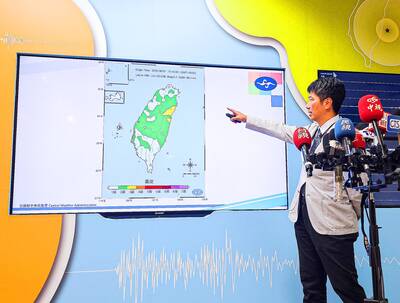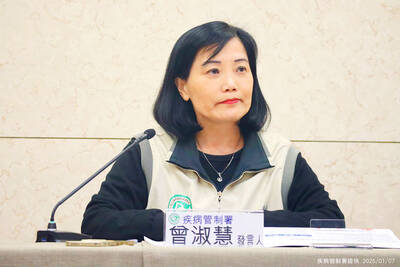Long-term projections have shown that rainfall is likely to decrease in the nation’s southern, central and northern areas and increase in eastern areas, researchers have said.
Liu Chung-ming (柳中明), a professor at National Taiwan University, said these developments were a result of shifting north eastern prevailing winds rather than climate change. However, climate change is likely to exacerbate the situation, creating more anomalies in rainfall patterns and possibly leading to longer droughts, he said.
“Taiwan’s eastern counties are likely to experience an increase in water supply compared with water use, while water supply may become more precarious in other regions, especially the central area,” Liu said.
He said these areas may experience shorter and more concentrated rainfall patterns that will do little to replenish water reserves in the nation’s reservoirs.
“In Tainan County, for example, the previous average for days without rain was 204. In the first 10 months of this year alone, there have been 252 days without rain — the figure is likely to be closer to 300 by the end of December,” Liu said.
In response, officials from Taiwan Water Corp said the company would monitor the situation and acknowledged that shifting weather patterns and climate change could result in longer droughts and more concentrated rainfall.
It would take a two-fold approach to address these changes, first by lowering water use through education and promotion, and then by limiting usage if necessary, the officials said.
Methods used to deal with water shortages range from reducing water pressure at night, placing restrictions on large water users like swimming pools and car washes, and, if necessary, alternating water rationing and stoppages between different areas, the officials said.
An official, who spoke on condition of anonymity because he was not authorized to comment on the matter, said water levels this year have been precarious and the corporation may start limiting water use in central and southern regions starting from the Lunar New Year, depending on levels of water reserves.
Water levels in reservoirs in the Miaoli area in central Taiwan, which are responsible for supplying Tainan and Kaohsiung, are at 50 percent of capacity compared to 84 percent in Shihmen Reservoir in northern Taiwan, the official said. As a result, it is likely there will be water shortages in the areas before the end of the dry season in May.
Officials at the Water Resources Agency (WRA) acknowledged that water shortages may increasingly become a problem in the future, and said that it was working on a series of initiatives to tackle the situation.
“Our data indicates that droughts may become more frequent in future years compared to 60 years ago. Rainfall disparity has risen to 1,500mm annually, from 1,000mm previously,” said WRA spokesman Wu Yueh-si (吳約西), who is also the agency’s deputy director-general, adding that floods and mudslides may become more common.
In recent years, the agency has been busy upgrading reservoirs to deal with increased silt from heavier rainfall and extreme weather such as Typhoon Morakot, Wu said, adding that the agency is also planning to create backup water sources while creating more sustainable water initiatives for towns and villages modeled on similar initiatives found in Japan.
While Wu ruled out large-scale water diversion projects to take advantage of Liu’s forecasts of increased rainfall in the east because of the nation’s mountainous geography, he said the agency was working on smaller initiatives such as a project to divert rainfall from parts of Hsinchu County to the area’s Pao-Shan Reservoir.
However, he said that while the agency has been working on initiatives to create a more stable supply of water in the face of the changing weather patterns, both the public and the agricultural industry should cut down on water use.
Statistics from the agency show that roughly 70 percent of water is used by agriculture and about 10 percent to 15 percent by households.
He added that the government’s policy was to decrease personal water consumption, which has remained steady for the past few years at 274 liters daily, to 250 liters.
The Environmental Quality Protection Foundation agreed with Wu and said that the public needs to start treating water as a precious commodity to stave off future problems.
“The government must increase the promotion and education of sustainable water initiatives ... It also needs to promote the healthy usage of water at home and hope the habits carry into the workplace,” said foundation chairman Hsieh Ying-shih (謝英士) in reference to decreasing industrial and agricultural water usage.
The foundation unveiled the nation’s first personal water calculation system earlier this month, the Taiwan Water Bank (waterbank.tw). Wu said this would show the public their true water usage by taking into account factors such as transportation, food and personal habits.
Users are then encouraged to cut down on their water use, with prizes for those that conserve the most. The sponsor of the program, Coca-Cola, has also pledged to sponsor an elementary school for every 100,000 liters of water saved, with the ultimate target of a reduction of 1 million liters.
“These water problems are going to continue to worsen, [we] need to start acknowledging that water is going to be increasingly important ... and stop taking it for granted,” Hsieh said.

The Taipei Summer Festival is to begin tomorrow at Dadaocheng Wharf (大稻埕), featuring four themed firework shows and five live music performances throughout the month, the Taipei Department of Information and Tourism said today. The festival in the city’s Datong District (大同) is to run until Aug. 30, holding firework displays on Wednesdays and the final Saturday of the event. The first show is scheduled for tomorrow, followed by Aug. 13, 20 and 30. To celebrate the 30th anniversary of Disney Pixar's movie Toy Story, the festival has partnered with Walt Disney Co (Taiwan) to host a special themed area on

Aftershocks from a magnitude 6.2 earthquake that struck off Yilan County at 3:45pm yesterday could reach a magnitude of 5 to 5.5, the Central Weather Administration (CWA) said. Seismological Center technical officer Chiu Chun-ta (邱俊達) told a news conference that the epicenter of the temblor was more than 100km from Taiwan. Although predicted to measure between magnitude 5 and 5.5, the aftershocks would reach an intensity of 1 on Taiwan’s 7-tier scale, which gauges the actual effect of an earthquake, he said. The earthquake lasted longer in Taipei because the city is in a basin, he said. The quake’s epicenter was about 128.9km east-southeast

BE CAREFUL: The virus rarely causes severe illness or death, but newborns, older people and those with medical conditions are at risk of more severe illness As more than 7,000 cases of chikungunya fever have been reported in China’s Guangdong Province this year, including 2,892 new cases last week, the Centers for Disease Control (CDC) yesterday said it is monitoring the situation and considering raising the travel notice level, which might be announced today. The CDC issued a level 1 travel notice, or “watch,” for Guangdong Province on July 22, citing an outbreak in Foshan, a manufacturing hub in the south of the province, that was reported early last month. Between July 27 and Saturday, the province reported 2,892 new cases of chikungunya, reaching a total of 7,716

STAY VIGILANT: People should reduce the risk of chronic liver inflammation by avoiding excessive alcohol consumption, smoking and eating pickled foods, the physician said A doctor last week urged people to look for five key warning signs of acute liver failure after popular producer-turned-entertainer Shen Yu-lin (沈玉琳) was reportedly admitted to an intensive care unit for fulminant hepatitis. Fulminant hepatitis is the rapid and massive death of liver cells, impairing the organ’s detoxification, metabolic, protein synthesis and bile production functions, which if left untreated has a mortality rate as high as 80 percent, according to the Web site of Advancing Clinical Treatment of Liver Disease, an international organization focused on liver disease prevention and treatment. People with hepatitis B or C are at higher risk of